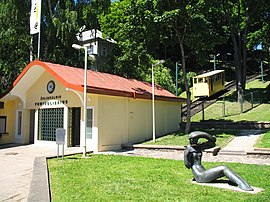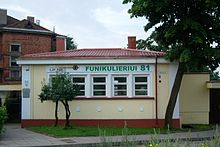Žaliakalnis funicular
| Žaliakalnis funicular | |||||||||||||
|---|---|---|---|---|---|---|---|---|---|---|---|---|---|
|
Žaliakalnis funicular
| |||||||||||||
| Route length: | 0.142 km | ||||||||||||
| Gauge : | 1200 mm | ||||||||||||
| Maximum slope : | 259 ‰ | ||||||||||||
|
|||||||||||||
Coordinates: 54 ° 54 ′ 3.8 ″ N , 23 ° 55 ′ 3.6 ″ E The Žaliakalnis funicular is one of three funiculars in Lithuania . The railway, the first in the city of Kaunas and in Lithuania, is one of the oldest funicular railways in Europe . It is located in the Žaliakalnis district.
Technical specifications
The inclined elevator has a track on which two cars run in opposite directions. These meet in a turnout in the middle of the route. The track consists of steel rails that were procured in Germany and have a gauge of 1200 mm. The route is 142 m long and has an incline of 25.9%. The carriages are made of wood and each can accommodate 36 passengers. They move at a speed of two meters per second and the journey takes one minute and 38 seconds.
The machinery is housed in the basement of the upper station. The system has a safety system in which the cars are braked with an automatic brake if the pull cord breaks.
history
At the turn of the 20th century, many citizens who worked in the lower town settled in the Žaliakalnis district . They wanted an improvement in the traffic conditions to the lower part of the city.
In 1927, Mayor Jonas Vileišis proposed the construction of a narrow-gauge railway via Palemonas and Vilijampolė to Žaliakalnis. The railway administration did not agree to the idea, mainly because of the high costs. This was followed by the proposal to build an urban electric tram . But the city council did not agree and decided to build a funicular.
In order to evaluate the flow of passengers, a count of the citizens who used the stairs was carried out in 1930. Tenders for the construction of the elevator were sent to Austrian , German and Swiss companies. The tender was won by the German company Curt Rudolph in Dresden , which signed the contract for delivery, advice and other aid projects with the city. The slope required to build and operate the elevator was purchased by its previous owners. Construction work lasted from October 1930 to spring 1931. The construction supervision was carried out by the President Antanas Smetona and the Mayor Juozas Vokietaitis.
On August 5, 1931, the funicular was officially opened and on August 8, it was opened for general use. One car was set up for passengers, the second was loaded with counterweights. The train up the hill quickly became very popular. In autumn it was decided to use a second passenger car. This was advertised in a competition that was won by the Lithuanian-American company AMLIT, a trading company with a lot of experience in automobile manufacture, trade and transport. An additional safety device was installed in the second car for passengers in the event that it collided with the lower end of the route.
Major renovations were carried out from 1935 to 1937. For this purpose, new wagons were procured for the route up the hill known as Napoleon Hill . These were manufactured by the Bell machine works in Switzerland. At the same time canopies were installed at the lower passenger station.
The fare was ten cents and five cents for school children. The fixed price for the descent was five cents. City officials as well as members of the police and fire brigade demanded a reduced fare or free travel, which was not granted.
The expansion of the district, the growing population, the creation of health care and industrial facilities made the inclined elevator an important and popular means of transport, which also attracted visitors to the city. In 1937 1,406,999, 1938 1,988,592 and 1939 2,291,477 passengers were carried. During the Second World War , the funicular remained intact and continued to operate.
During the Soviet era, the funicular, like the Aleksoto funicular, was operated by the Troleibusai Kaune bus company . The fare was now one kopeck . In 1970 more than five million passengers were carried. In 1986 extensive repairs were necessary. The upper station received new platforms, the lower one received a new building. The sculpture Girl with a Small Pipe , created by Broniaus Zalenso , was placed in the forecourt .
From 1992, the funicular was from the company EBSW company belonging to Ciklonas operated. Due to poor planning by the operator, the railway, which was never profitable at that time, was up for auction in 2002. In March 2003, UAB “Kauno liftai” bought the funicular and restored it authentically in the style of 1931.
During the journey, music by the composer Giedrius Kuprevičius can be heard in the carriages . The staff wears uniforms from the period between the two world wars. On September 15, 2004, a photo exhibition was opened in the mountain station.
Technical monument
The funicular is the first of its kind in Lithuania, published on November 30, 1996 in a list of cultural treasures of historical, technological and architectural value. On October 24, 1997 it was added to the list of cultural monuments . On October 9, 2003, the Lithuanian government declared the railway a cultural monument.
On October 16, 2004, the Lithuanian Post issued two postage stamps depicting the funiculars in Kaunas. Both stamps had a circulation of 600,000 copies with a face value of 1 and 1.3 litas.
The buildings of the cable car stations are an integral part of the city center of Kaunas, like the Church of the Resurrection and its architectural ensemble. An average of 400 to 600 passengers use the inclined elevator every day.
Individual evidence
- ↑ a b Žilvinė PETRAUSKAITĖ: Gimtadienio tostas Žaliakalnio funikulieriui. In: Kauno diena . August 5, 2006, accessed May 12, 2014 (Lithuanian).
- ↑ Kauno miesto tvarkymas ir svarbiausi Ateities darbai. In: Darbas. June 9, 1940, p. 3 , accessed May 14, 2014 (Lithuanian).
- ↑ Laimius Stražnickas: Kelionė į Kalna senoviniu vagonėliu. In: delfi.lt. May 13, 2012, Retrieved May 14, 2014 (Lithuanian).
- ↑ Dainoras LUKAS: Žaliakalnio funikulierius atsidūrė aukcione. In: Kauno diena . September 11, 2002, accessed May 12, 2014 (Lithuanian).
- ↑ Žaliakalnio funikulieriaus statinių kompleksas. Kultūros paveldo departamentas prie Kultūros ministerijos, accessed on May 12, 2014 (Lithuanian).
- ↑ DĖL NEKILNOJAMŲJŲ KULTŪROS VERTYBIŲ PASKELBIMO KULTŪROS PAMINKLAIS. Retrieved May 12, 2014 (Lithuanian).
- ↑ Kauno funikulieriai pavaizduoti pašto ženkluose. In: Kauno diena . Retrieved May 12, 2014 (Lithuanian).
Web links
- Žaliakalnio funikulierius. Archived from the original on March 16, 2010 ; Retrieved May 15, 2014 (Lithuanian).
- Funikulieriaus mašinistas: darbas, kurio nekeisčiau į kitą profesiją. delfi.tv, accessed on May 12, 2014 (Lithuanian, film about the funicular).


